Text
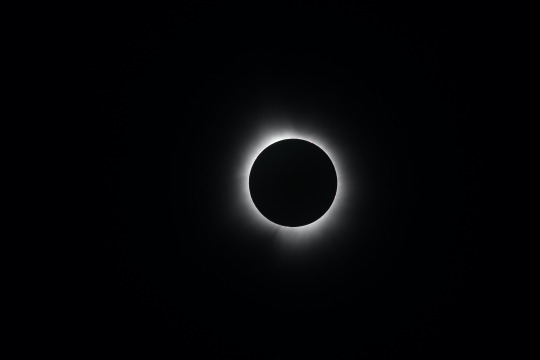
The total eclipse in Carbondale, Illinois,
From the campus of Southern Illinois University,
Photo by Scott Olson/Getty Images
#art#cosmos#cosmic#universe#blast#space#wallpaper#photography#moon#eclipse 2024#lunar eclipse#eclipse#illinois#carbondale#scott olson
15 notes
·
View notes
Text

A sliver of the sun in Torreón, Mexico !
Photo by Getty Images
#art#cosmos#cosmic#universe#blast#space#wallpaper#photography#lunar eclipse#moon#eclipse 2024#mexico#torreon#getty image#eclipse
13 notes
·
View notes
Text
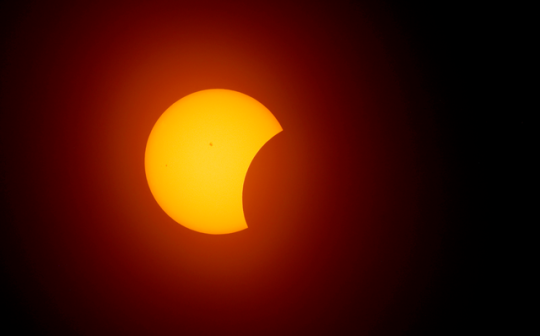
Fort Worth, Texas, April 8
The moon begins to eclipse the sun on April 8, 2024 in Fort Worth, Texas.
Millions of people have flocked to areas across North America that are in the "path of totality" in order to experience a total solar eclipse. During the event, the moon will pass in between the sun and the Earth, appearing to block the sun.
Photo by Ron Jenkins/Getty Images
#art#cosmos#cosmic#universe#blast#space#wallpaper#eclipse#texas#fort worth#path of totality#eclipse 2024#sun#earth#ron jenkins
5 notes
·
View notes
Text

NGC 604 !
This is a JWST image of NGC 604, a star-forming region about 2.7 million light years from Earth.
Credit: NASA /ESA / CSA /STScl
#art#cosmos#cosmic#universe#blast#space#photography#stars#light#NGC 604#JWST#IMAGE#NASA#ESA#CSA#STScl
21 notes
·
View notes
Text

The Phantom Galaxy, M74 !
M74 shines at its brightest in this combined optical/mid-infrared image, featuring data from both the NASA/ESA Hubble Space Telescope and the NASA/ESA/CSA James Webb Space Telescope.
With Hubble’s venerable Advanced Camera for Surveys (ACS) and Webb’s powerful Mid-InfraRed Instrument (MIRI) capturing a range of wavelengths, this new image has remarkable depth. The red colours mark dust threaded through the arms of the galaxy, lighter oranges being areas of hotter dust. The young stars throughout the arms and the nuclear core are picked out in blue. Heavier, older stars towards the galaxy’s centre are shown in cyan and green, projecting a spooky glow from the core of the Phantom Galaxy. Bubbles of star formation are also visible in pink across the arms. Such a variety of galactic features is rare to see in a single image.
Scientists combine data from telescopes operating across the electromagnetic spectrum to truly understand astronomical objects. In this way, data from Hubble and Webb compliment each other to provide a comprehensive view of the spectacular M74 galaxy.
Credit: ESA/Webb, NASA & CSA, J. Lee and the PHANGS-JWST Team; ESA/Hubble & NASA, R. Chandar Acknowledgement: J. Schmidt
#art#cosmos#cosmic#universe#blast#space#wallpaper#galaxy#phantom#M74#infrared#esa#nas#csa#MIRI#ACS#phantom galaxy#cosmos wallpaper
24 notes
·
View notes
Text
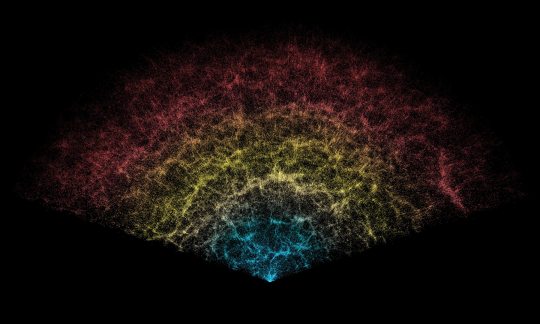
DESI Map !
A slice of the 3D map of galaxies collected in the first year of the Dark Energy Spectroscopic Instrument (DESI) Survey. Earth is at the tip, with the furthest galaxies plotted at distances of 11 billion light-years. Each point represents one galaxy.
This version of the DESI map includes 600,000 galaxies — less than 0.1% of the survey's full volume.
Credit: DESI Collaboration/NOIRLab/NSF/AURA/R. Proctor
#art#cosmos#cosmic#universe#blast#space#wallpaper#desi map#3D map#galaxies#galaxy#dark energy spectroscopic instrument#survey#NOIRlab
22 notes
·
View notes
Text

Forming Stars !
The James Webb Space Telescope has captured a tightly bound pair of actively forming stars, shown here as the orange-white splotch in the middle of the red diffraction spikes, at image centre. Two immense lobes of gas and dust stretch away from the pair in opposite directions.
Credit: NASA, ESA, CSA, Joseph DePasquale (STScI), Anton M. Koekemoer (STScI)
#art#cosmos#cosmic#universe#blast#space#wallpaper#photography#stars#forming star#james webb space telescope#nasa#esa#csa
35 notes
·
View notes
Text

"Prthvî"
From: The Devine Element, Vol by Divyaman Singh
Courtesy: Iftikar/Abir Pothi
5 notes
·
View notes
Text

Purple and Brown Colored Planet
Courtesy: Pixabay
17 notes
·
View notes
Text

"Solar Flare"
Courtesy: Pixabay
#art#cosmos#cosmic#universe#space#wallpaper#photography#blast#red#orange#sun#solar#solar flare#pixabay#space wallpaper
6 notes
·
View notes
Text

White Space Ship and Brown Planet
Courtesy: SpaceX
#art#cosmos#cosmic#space#wallpaper#stars#universe#spaceship#planet#brown planet#spacex#space wallpaper
7 notes
·
View notes
Text
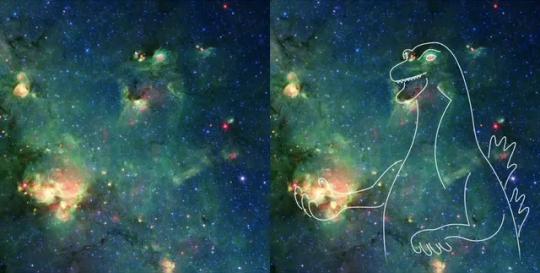
Godzilla Nebula !
NASA's Spitzer telescope spotted a nebula that looks like it could rise up out of the ocean and flatten a city if it felt like it. NASA JPL talked up the wild image in 2021 just in time for Halloween, saying it looks like a cosmic portrait of infamous movie monster Godzilla!
#art#cosmos#cosmic#universe#blast#space#photography#stars#godzilla#nebula#funny#fun#funny picture#haloween#nasa#spitzer telescope#jpl#monster#surreal
27 notes
·
View notes
Text










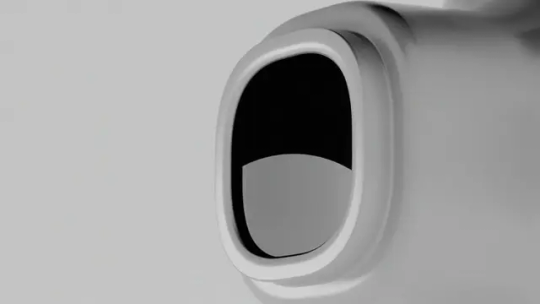
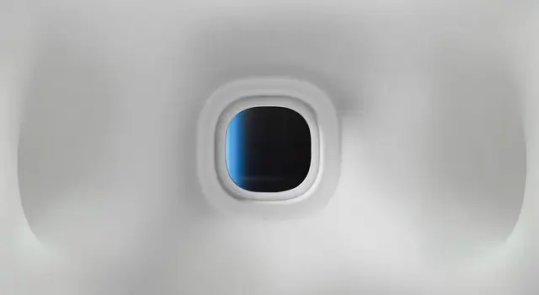

Acromania Orbit Hotel !
The hotel consists of independent units that can exist independently or form a larger integrated network together. Each unit has a hexagonal structure that allows for integration into larger systems.
The interior is covered in smart, responsive materials with clever shape-shifting properties. It can be transformed into partitions and structures. For relaxation and various activities, all elements, including furniture, are formed according to the needs of the inhabitants.
Walls envelop a person during sleep. Navigation devices and buttons Appears on the inner wall as a bas-relief. To facilitate and open up various experiences to guests with micropore This allows sound, light, smell, and air to circulate.
Courtesy: Acromania
#art#design#architecture#boutique hotel#travels#interior design#luxury lifestyle#luxury hotels#interiors#hotel concept#orbital#space hotel#white#acromania#space#luxury hotel#space tourism#habitat#concept#extraterrestrial#contemplation
21 notes
·
View notes
Text
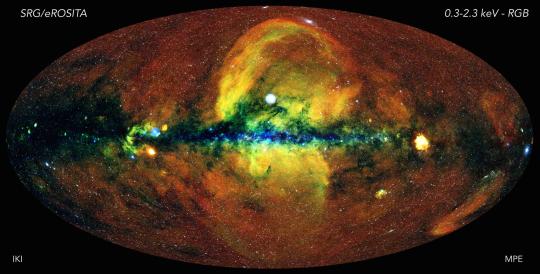
The universe as seen with the eROSITA X-ray telescope
As eROSITA scans the sky, the energy of the collected photons is measured with an accuracy ranging from 2% – 6%.
To generate this image, in which the whole sky is projected onto an ellipse (so-called Aitoff projection) with the center of the Milky Way in the middle and the body of our Galaxy running horizontally, photons have been color-coded according to their energy (red for energies 0.3-0.6 keV, green for 0.6-1 keV, blue for 1-2.3 keV).
The red diffuse glow away from the galactic plane is the emission of the hot gas in the vicinity of the Solar System (the Local Bubble). Along the plane itself, dust and gas absorb the lowest energy X-ray photons, so that only high-energy emitting sources can be seen, and their color appears blue in the image.
The hotter gas close to the Galactic center, shown in green and yellow, carries imprinted the history of the most energetic processes in the life of the Milky Way, such as supernova explosions, driving fountains of gas out of the plane, and, possibly, past outburst from the now dormant supermassive black hole in the center of the Milky Way.
Piercing through this turbulent, hot diffuse medium, are hundreds of thousands of X-ray sources, which appear mostly white in the image, and uniformly distributed over the sky. Among them, distant active galactic nuclei are visible as point sources, while clusters of galaxies reveal themselves as extended X-ray nebulosities.
In total, about one million X-ray sources have been detected in this image.
Image credit: Jeremy Sanders, Hermann Brunner & the eSASS team / Max Planck Institute for Extraterrestrial Physics / Eugene Churazov & Marat Gilfanov, IKI.
#art#cosmos#cosmic#universe#blast#wallpaper#photography#x_ray#eROSITA#telescope#x-ray telescope#aitoff projection#space#stars#space wallpaper#universe wallpaper
47 notes
·
View notes
Text

Comet 12P
Potograph taken in Pons-Brooks on the evening of March 16th. The comet is still 151 million miles away and slowly getting closer. The comet is also slowly brightening but also getting lower in the sky after sunset making it more difficult to capture. It will continue to get closer to the Sun over the next few weeks and become more difficult to see.
There was only about 40 mins from the start of darkness after sunset to when the comet set in the northeast. The comet is now magnitude 5, technically making it visible to the naked eye under a very dark sky, but practically speaking you will need binoculars to see it.
Courtesy: Stars Over Bucks
#art#cosmos#cosmic#universe#blast#space#photography#comet#comet 12P#pons-brooks#march#starsoverbucks
50 notes
·
View notes
Text
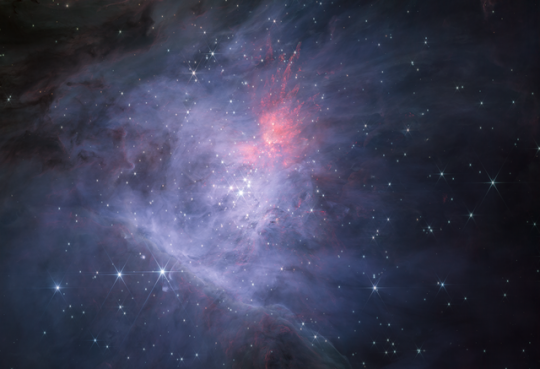
Wavelength mosaic image,
Webb focuses on the Orion Nebula and its stars.
Credit: NASA / ESA / CSA
#art#cosmos#cosmic#universe#blast#wallpaper#photography#stars#space#mosaic#nebula#orion#nasa#esa#csa#image#space wallpaper
2 notes
·
View notes
Text

Orion Nebula
New James Webb Space Telescope images of the Orion Nebula uncover a plethora of new details in the vast star-forming region.
Credit: NASA / ESA / CSA
#art#cosmos#cosmic#universe#blast#photography#wallpaper#space wallpaper#orion#nebula#nasa#esa#new james webb space telescope#csa
18 notes
·
View notes